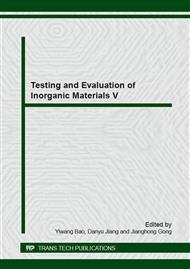[1]
N.Q. Feng, F. Xing, Concrete and the durability of concrete structure, Beijing, Mach. Ind. Press, (2009).
Google Scholar
[2]
M.S. Tang, Talk about volume stability of cement-based materials, China. Build. Mater. 3(2002) 35-36.
Google Scholar
[3]
P.K. Mehta, Durability-critical issues for the future, Concr. Int. 19 (1997) 27-32.
Google Scholar
[4]
K.M.A. Hossain, M. Lachemi, Strength, durability and micro-structural aspects of high performance volcanic ash concrete, Cem. Concr. Res. 37 (2007) 759-766.
DOI: 10.1016/j.cemconres.2007.02.014
Google Scholar
[5]
T.M. Wang. Crack control of engineering structure, Beijing, China Archit. Ind. Press, (1997).
Google Scholar
[6]
S.N. Shoukry, G.W. William, B. Downie, etc, Effect of moisture and temperature on the mechanical properties of concrete, Constr. Build. Mater. 25 (2011) 688-696.
DOI: 10.1016/j.conbuildmat.2010.07.020
Google Scholar
[7]
Z.P. Bazant, Advances in material modeling of concrete, in: A. H. Hadjian, Tenth International Conference on Structural Mechanics in Reactor Technology (SMiRT10) Anaheim, CA 1989, pp.301-330.
Google Scholar
[8]
M.B. Dwaikat, V.K.R. Kodur, Hydrothermal model for predicting fire-induced spalling in concrete structural systems, Fire Safety J. 44 (2009) 425-434.
DOI: 10.1016/j.firesaf.2008.09.001
Google Scholar
[9]
M. Benes, P. Mayer, Coupled model of hygro-thermal behavior of concrete during fire, J. Comput. Appl. Math. 218 (2008) 12-20.
Google Scholar
[10]
M. Zeiml, etc, Thermo-hydro-chemical couplings considered in safety assessment of shallow tunnels subjected to fire load, Fire Safety Journal. 43 (2008) 83-95.
DOI: 10.1016/j.firesaf.2007.05.006
Google Scholar
[11]
M. Qin, R. Belarbi, A. Aiet-Mokhtar, etc, Coupled of heat and moisture transfer in multi-layer building materials, Constr. Build. Mater. 23 (2009) 967-975.
DOI: 10.1016/j.conbuildmat.2008.05.015
Google Scholar
[12]
S. Grasberger, G. Meschke, A hygro-thermal-poroplastic damage model for durability analyses of concrete structures, Proceedings of the European Congress on Computational Methods in Applied Sciences and Engineering, Barcelona, CIMNE, (2000).
Google Scholar
[13]
G.T. Liu, X.G. Jiao, Coupled heat and moisture transfer analysis of concrete, J. Tsinghua U. (Sci. Tech). 44 (2004) 1653-1655, 1671.
Google Scholar
[14]
D.H. Huang, G.T. Liu, Study on mass diffusivity of concrete under isothermal condition, J. Basic Sci. Eng. Appl. 10 (2002) 386-394.
Google Scholar
[15]
S.R. Luo, J.L. Zheng, Z.P. Zheng, High strength and high performance concrete temperature and humidity stress field analysis, J. safety environ. 4 (2004) 42-44.
Google Scholar
[16]
C.R. Lu, etc, Test and research on concrete cracking with temperature, Humidity and Wind Speed Influence, South-to-North Water Transfers and Water Sci & Tech. 7 (2009) 66-69, 80.
Google Scholar
[17]
C. Andrade, Relative humidity in the interior of concrete exposed to natural and artificial weathering, Cem. Concr. Res. 29 (1999) 1249-1259.
DOI: 10.1016/s0008-8846(99)00123-4
Google Scholar
[18]
D. Gawin, K. Witczak, Effect of solar radiation and precipitation upon hygrothermal performance and stresses of a building wall, ISECO Sci. Tech. Vision. 5 (2009) 76-80.
Google Scholar
[19]
D. Gawin, etc, Modeling hygro-thermal performance and strains of cementitious building materials maturing in variable conditions, J. Build. Phys. 31 (2008) 301-318.
DOI: 10.1177/1744259108089992
Google Scholar
[20]
H. Wang, C.X. Qian, M. Li, W. Sun, Study on relationship between moisture diffusivity and fire spalling of high strength concrete, J. Southeast U. (Natur. Sci. Edition). 33 (2003) 454-457.
Google Scholar
[21]
H. Wang, C.X. Qian, M. Li, W. Sun, Study on moisture diffusivity of high strength concrete after fire, Ind. Build. 33 (2003) 66-69.
Google Scholar
[22]
D.P. Chen, C.X. Qian, Determination of moisture diffusion in cement-based materials in the presence of knudsen diffusion, J. Build. Mater. 12 (2009) 635-638.
Google Scholar
[23]
S.B. Tang, C.A. Tang, etc, Study of thermal conduction and thermal stress of concrete at mesoscopic level and its thermal cracking processes, China Civil Eng. J. 45 (2012) 11-19.
Google Scholar
[24]
J.W. Du, G.P. Gao, R.M. Wen, An experimental study of thermal conductivity of rubber tire concrete (RTC), Tsinghua University, The Sixth Natl. Civil Eng. Forum, (2008).
Google Scholar
[25]
D.P. Chen, Multi-physical field coupling simulation of hygro-thermal deformation of concrete, J. Southeast U. (Natur. Sci. Edition). 43 (2013) 582-587.
Google Scholar
[26]
D.P. Chen, C.X. Qian, C.W. Miu, J.P. Liu, Analytical calculation of coupled heat and moisture deformation of concrete-Combining finite element method, J. Southeast U. (Natur. Sci. Edition). 40 (2011) 89-95.
Google Scholar
[27]
P. Gao, P.H. Li, K.M. Bao, Research on coupled heat and moisture transfer of mass concrete, J. China Three Gorges U. (Natur. Sci). 34 (2012) 29-34.
Google Scholar
[28]
A.V. Luikov, Heat and mass transfer in capillary porous bodies, Oxford, Pergamon, (1966).
DOI: 10.1016/b978-1-4832-0065-1.50010-6
Google Scholar
[29]
R. Černý, P. Rovnaníková. Transport process in concrete, London, Spon Press (UK), (2002).
Google Scholar
[30]
Z.P. Bazant, J.C. Chern, W. Thonguthai, Finite element program for moisture and heat transfer in heated concrete, Nuclear Eng. Design, 68 (1981) 61-70.
DOI: 10.1016/0029-5493(82)90040-1
Google Scholar
[31]
R.T. Li, X.K. Li. The numerical simulation and destruction in Chemistry-Thermo-Hygro-Mechanical coupling process of concrete, Chinese J. Theor. App. Mech. 38 (2006) 471-479.
Google Scholar
[32]
S. Chen, M.Y. Ke, H.X. Liu, etc, Finite element analysis of mechanical behaviors of concrete creep based on the porous media theory, Chinese J. Solid Mech. 30 (2009) 522-526.
Google Scholar
[33]
C.X. Qian, D. P. Chen, Y.J. Liu, Programming for simulation of hygrothermal deformation in concrete, Indian Con. J. 83 (2009) 9-16.
Google Scholar
[34]
C.X. Qian, D.P. Chen, Simultaneous Heat and Moisture Transfer in Concrete with Time-dependent Boundary Conditions, Mag. Con. Res. 60 (2008) 725-733.
DOI: 10.1680/macr.2008.00021
Google Scholar
[35]
D.P. Chen, etc, Numerical simulation of concrete shrinkage based on heat and moisture transfer in porous medium, J. Southeast U. (Engl. Edition). 23 (2007) 75-80.
Google Scholar
[36]
D.P. Chen, C.X. Qian, C. L Liu, A Numerical Simulation Approach to Calculating Hygrothermal Deformation of Concrete Based on Heat and Moisture Transfer in Porous Medium[J]. Int. J. Civil Eng. 8 (2010) 287-296.
Google Scholar
[37]
D.P. Chen, Numerical simulation and application of coupled heat and moisture deformation of concrete based on heat and moisture transfer theory in porous medium, Nanjing, Southeast University, (2007).
Google Scholar
[38]
W.B. Ma, G. Li, Research on the temperature and humidity response of concrete internal under the natural climate conditions, Con. Cem. Prod. 2 (2007) 18-21.
Google Scholar


